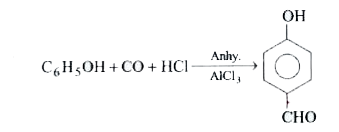The formation of cyanohydrin from a ketone is an example of
nucleophilic substitution
electrophilic substitution
electrophilic addition
nucleophilic addition.
A
Electrophilic addtion
B
Nucleophilic addtion
C
Nucleophilic substitution
D
Electrophilic substitution
Video Solution
Text Solution
The correct Answer is:B
Aldehydes and ketones undergo NA reactions.
|
Topper's Solved these Questions
- ORGANIC REACTION MECHANISMBOOK - CENGAGE CHEMISTRY ENGLISHCHAPTER - ORGANIC REACTION MECHANISMEXERCISE - True/False
2 Videos
- ORGANIC REACTION MECHANISMBOOK - CENGAGE CHEMISTRY ENGLISHCHAPTER - ORGANIC REACTION MECHANISMEXERCISE - Analytical and Descriptive
6 Videos
- ORGANIC REACTION MECHANISMBOOK - CENGAGE CHEMISTRY ENGLISHCHAPTER - ORGANIC REACTION MECHANISMEXERCISE - Assertion-Reasoning
12 Videos
- NCERT BASED EXERCISEBOOK - CENGAGE CHEMISTRY ENGLISHCHAPTER - NCERT BASED EXERCISEEXERCISE - Chemical Equilibrium
73 Videos
- P-BLOCK GROUP 13 - BORON FAMILYBOOK - CENGAGE CHEMISTRY ENGLISHCHAPTER - P-BLOCK GROUP 13 - BORON FAMILYEXERCISE - Exercise Archives (Subjecive)
9 Videos
Similar Questions
Knowledge Check
Which of the following reactions is not an example of electrophilic substitution ?
AC6H6++NO2→C6H5NO2+H+BC6H5+CH3ClAlCl3−−→C6H5−CH3+HClCC6H6+Cl2UV light−−−−→C6H6Cl6DC6H5OH+CO+HClAnhy−−→AlCl3

Which one is a nucleophilic substitution reaction among the following ?
ARCHO+R'Mgx→R−C∣OHH−RBCH3−CH2−oevrset(CH3)∣CH−CH2Br+NH3→CH3−CH2−CH3∣CH−CH2NH2CCH3CHO+HCN→CH3CH(OH)CNDCH3−CH=CH2+H2OH+−−→CH3−C∣OHH−CH3
Which of the following reactions is an example of nucleophilic substitution reaction?
View SolutionGive three examples of electrophilic substitution reactions.
View SolutionWhich reaction is not an example of nucleophilic addition reaction?
View SolutionHaloalkanes undergo nucleophilic substitution whereas haloarenes undergo electrophilic substitution. Explain
View SolutionWhich of the following is an example of nucleophilic addition to acetaldehyde ?
View SolutionWhich of the following is least reactive towards nucleophilic substitution?
View Solution
